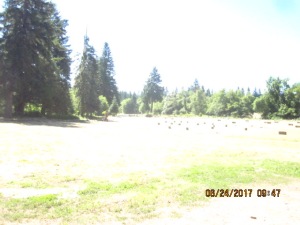The main herd has been enjoying the extra room for grazing because of the harvested far, far field. We opened up the temporary electric fence so they can wander around the full field, the perimeter, under large leaf maple trees and tall fir. They can meander the upper field and down in the dip by the riparian. They can also watch us as we try to make the next field into hay by watching across the river.
This open field that they have been in since we finished the far, far field has been good for the herd, but the time they can stay over there is running out and they are thinking it is about time to return to the barn side of the river and all the clover that is growing. They would also love to clean up the hay field but we have still not had enough heat during the days to dry the hay enough to bale. Mike has fluffed this field four times now and he is still rolling up green grass because the ground has stayed moist.
We are hoping tomorrow to be able to get the field raked into windrows but we will have to see how that goes. For now, the main herd will have to be content with the grazing area they have and we are supplementing a couple of bales of hay a day just to keep them happy while we work on the next area for grazing.
You gotta see the pictures! They are posted with this story on SchmidlinAngusFarms.com. While you are there, if there is any online shopping you plan on doing, please go through my picture links. By doing so, I may make a small commission without a charge to you! The commissions help pay for my user charges for this site, Thank You for supporting the farm stories.








